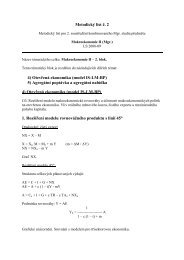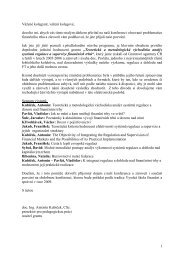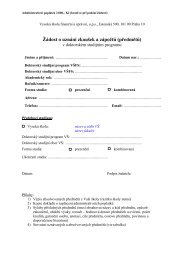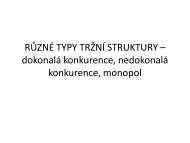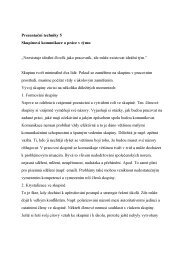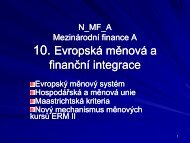(Microsoft PowerPoint - file [jen pro \350ten\355]) - IS VŠFS
(Microsoft PowerPoint - file [jen pro \350ten\355]) - IS VŠFS
(Microsoft PowerPoint - file [jen pro \350ten\355]) - IS VŠFS
You also want an ePaper? Increase the reach of your titles
YUMPU automatically turns print PDFs into web optimized ePapers that Google loves.
CORPORATE FINANCEMANAGEMENT 2Master Course <strong>VŠFS</strong>Fall 2012Irena Jindřichovskáirena.jindrichovska@mail.vsfs.czDr Irena Jindrichovska Corporate Finance Management 2 1
Literature• Brigham, E and Ehrhardt, M (2004) Financial management:theory and practice, 13th ed., Thomson Learning <strong>IS</strong>BN-10:0324259689; <strong>IS</strong>BN-13: 9780324259681• Other recommended sources:• Brealey, R., Myers, S. and Allen, F. (2006) Corporate Finance,8th international ed., McGraw-Hill <strong>IS</strong>BN: 0-07-111795-4• Ross, Westerfield & Jaffe; Fundamentals of Corporate Finance,4th edition• Bender and Ward: Corporate Financial Strategy, 3rd ed.Butteworth-Heinemann, 2009• More sources may be recommended in lecturesDr Irena Jindrichovska Corporate Finance Management 2 2
Teaching plan• Regular studies:12 hours lectures6 hours excercises+ presentation of own work• Assignment conditions - essay on topic given + activeparticipation in seminars• Exam: Written exam consisting of short essays andcalculationsDr Irena Jindrichovska Corporate Finance Management 2 3
Outline of the course1. Introduction to Corporate finance management2. Mergers and acquisitions3. Cost of capital and capital structure4. Strategy and tactics of financing decisions -investment decision making5. Capital Restructuring and Multinational Fin.Management6. Lease Financing and Working CapitalManagementDr 7. Irena Risk Jindrichovska Management Corporate and Finance Real Management Options 2 4
INTRODUCTION TOCORPORATE FINANCEMANAGEMENTDr Irena Jindrichovska Corporate Finance Management 2 5
Outline Lecture 1• Introduction• Capital structure• Company lifecycle• Role of financial manager• Financial markets• Agency theory• Stakeholders’ theory• Summary, exercises, referencesDr Irena Jindrichovska Corporate Finance Management 2 6
Introduction toCorporate Finance• Basic questions not only from corporatefinance:1. What long-term investment strategyshould a company take on?2. How can cash be raised for the requiredinvestments?3. How much short-term cash flow does acompany need to pay its bills?Dr Irena Jindrichovska Corporate Finance Management 2 7
The Balance-Sheet Model of theFirm• Current assets• Current liabilities– Net working capital• Long term debt• Fixed assets– Tangible fixed assets– Intangible fixed assets• Shareholders’ equityDr Irena Jindrichovska Corporate Finance Management 2 8
Capital Structure• Financing arrangements determine howthe value of the firm is sliced up.• The firm can then determine its capitalstructure.• Capital structure changes in the lifetime ofthe firmDr Irena Jindrichovska Corporate Finance Management 2 9
Capital Structure• The firm might initially have raised thecash to invest in its assets by issuing moredebt than equity;• Later again it can consider changing thatmix by issuing more equity and using the<strong>pro</strong>ceeds to buy back some of its debtDr Irena Jindrichovska Corporate Finance Management 2 10
Life Cycle of the company andits funding• Boston Consulting Group Matrix• Axes– horizontal: speed of growth of the market share– vertical: market share• Start-up• Growth• Maturity• Decline• Each phase requires different ap<strong>pro</strong>ach to financialmanagement – according to generated Cash FlowDr Irena Jindrichovska Corporate Finance Management 2 11
Life Cycle of the company IIMaturity•Low investment need•High CF generated•Growth•High investment need•High CF generatedDecline•Low investment need•Low CF generated•Start up•High investment need•Low CF generatedDr Irena Jindrichovska Corporate Finance Management 2 12
Role of the Financial Manager1. The firm should try to buy assets thatgenerate more cash than they cost.2. The firm should sell bonds and stocks andother financial instruments that raise morecash than they cost.Dr Irena Jindrichovska Corporate Finance Management 2 13
Role of the Financial Manager• The firm must create more cash flow thanit uses.• The cash flows paid to bondholders andstockholders of the firm should be higherthan the cash flows put into the firm by thebondholders and stockholders.Dr Irena Jindrichovska Corporate Finance Management 2 14
Financial Markets• Primary and secondary markets• Spot and forward markets• Money markets• Equity markets• Organized and over-the-counter markets– LSE, AMEX, NYSE; NASDAQ• Derivative markets– LIFFE, CBOTDr Irena Jindrichovska Corporate Finance Management 2 15
Primary and secondary markets1• Help to get financing for companies• Investment companies• Pool together and manage the money ofmany investors• Arrange corporate borrowings and securityissues– Issuing <strong>pro</strong>cessDr Irena Jindrichovska Corporate Finance Management 2 16
Primary and secondary markets2• Establish the price of securities throughsupply and demand• Execute and settle the transaction• Guarantee the settlement through the‘Clearing house’- a special institutionconnected with each Stock Exchange– There is also a securities exchangecommission (SEC ) setting the standards andrules of listingDr Irena Jindrichovska Corporate Finance Management 2 17
Agency Theory• There are two groups with different interest ineach corporation – Shareholders and Managers• Goals of shareholders and managers are not thesame• Jensen and Meckling (1976): Theory of the Firm:Managerial Behavior,Agency Costs andOwnership Structure, JFE 1976• Defined Principal – Agent relationDr Irena Jindrichovska Corporate Finance Management 2 18
Principal - Agent• Owners i.e. Shareholders are Principals• Managers are Agents• Shareholders want value of their firm to bemaximized• Managers should act on principals’ behalfbut have different goalsDr Irena Jindrichovska Corporate Finance Management 2 19
Management Goals• Survival - avoid risky business decisions• Selfsufficiency – prefer internal financing toissuance of new stock• Shareholders need to control management –Agency Costs –– Monitoring costs– Incentive fees to convince management to act inshareholders’ interestDr Irena Jindrichovska Corporate Finance Management 2 20
Control methods• Directors are voted by Shareholders andmanagement is selected by directors• Management compensation methods– Stock option plan– Bonuses– Performance shares• Threat of takeovers• Competition on management labor marketDr Irena Jindrichovska Corporate Finance Management 2 21
Stakeholders’ theory• All interested parties that have some relation tothe company– Shareholders– Employees– Creditors– Banks– Suppliers– Clients– Environment– MunicipalitiesDr Irena Jindrichovska Corporate Finance Management 2 22
Summary1. The goal of financial management in a for-<strong>pro</strong>fitbusiness is to make decisions that increase the valueof the stock, or, more generally, increase the marketvalue of the equity.2. Business finance has three main areas of concern:a. Capital budgeting. What long-term investments should the firmtake?b. Capital structure. Where will the firm get the long-term financingto pay for its investments? In other words, what mixture of debtand equity should we use to fund our operations?c. Working capital management. How should the firm manage itseveryday financial activities?Dr Irena Jindrichovska Corporate Finance Management 2 23
Summary 23. The corporate form of organization is superiorto other forms when it comes to raising moneyand transferring ownership interests, but it hasthe significant disadvantage of double taxation.4. There is the possibility of conflicts betweenstockholders and management in a largecorporation. We call these conflicts “agency<strong>pro</strong>blems” and discussed how they might becontrolled and reduced.Dr Irena Jindrichovska Corporate Finance Management 2 24
Exercise <strong>pro</strong>blems• Define and compare the three forms oforganisation a <strong>pro</strong>prietorship, a partnershipand a corporation.• Explain the agency <strong>pro</strong>blem and discuss therelationship between managers andshareholders– What are the two types of agency costs?– How are managers bonded to shareholders?– Can you recall some managerial goals?– What is the set-of-contracts perspective?Dr Irena Jindrichovska Corporate Finance Management 2 25
Useful web source• On Agency theory – A review paper• http://classwebs.spea.indiana.edu/kenricha/Oxford/Archives/Oxford%202006/Courses/Governance/Articles/Eisenhardt%20-%20Agency%20Theory.pdfDr Irena Jindrichovska Corporate Finance Management 2 26
RECOMENDED READINGS• Brigham and Houston: Fundamentals ofFinancial Management, 12th ed, Ch 1• Ross, Westerfield & Jaffe; Fundamentalsof Corporate Finance, 4th edition Ch 1and 2• Bender and Ward: Corporate FinancialStrategy, 3 rd ed. Butteworth-Heinemann,2009, Ch 2Dr Irena Jindrichovska Corporate Finance Management 2 27
COST OF CAPITAL ANDCAPITAL STRUCTUREDr Irena Jindrichovska Corporate Finance Management 2 28
Outline• Introduction• Sources of long term financing• Debt versus equity• Long term debt• Preferred shares• Retained earnings• Newly issued shares,– Gordon model, debt plus risk premium, CAPM ap<strong>pro</strong>ach• WACC• Value of a company• Summary, exercises, referencesDr Irena Jindrichovska Corporate Finance Management 2 29
Equity versus debtFeature: Equity DebtIncome: Dividends InterestTaxTaxed as personal income.Taxed as personal income.status: Are not business expense Are business expenseControl:Common stocksControl is exercised with(sometimes preferred) loan agreementusually have voting rightDefault:Bottomline:Firms cannot becomebankrupt for nonpayment ofdividendsUnpaid debt is a liability.Nonpayment results inbankruptcyTax status favours debt, but default favours equity.Control features of debt and equity are different but one isnot better than otherDr Irena Jindrichovska Corporate Finance Management 2 30
Long term debt• Loans and bonds– Loans (interest is paid before taxes –creation of tax shield, that lowers the costof L/T debt); T = tax ratekd=k( 1−T)nom– Bonds (yield to maturity)B=−t1−(1+ r))MC +r (1+r)Dr Irena Jindrichovska Corporate Finance Management 2 31t
Preferred shares• Perpetuity P = C/r; i.e.k p = C / P• May need to take in considerationissuance cost (flotation cost F)k p = C / (P-F)Dr Irena Jindrichovska Corporate Finance Management 2 32
Cost of retained equity• Using Gordon model of growingperpetuity:• P=D 1 / (r-g); i.e.k s = (D 1 / P) + gDr Irena Jindrichovska Corporate Finance Management 2 33
Cost of new equity• Using Gordon model of growing perpetuitytaking in consideration flotation cost:k e = (D 1 / (P-F)) + gDr Irena Jindrichovska Corporate Finance Management 2 34
The CAPM ap<strong>pro</strong>ach• Estimate using the CAPM– Estimate of risk free rate r RF– Estimate the market premium RP M– Estimate the stock’s beta coefficient β s– Substitute in the CAPM equation:rs)β=r+ (RPRFMsDr Irena Jindrichovska Corporate Finance Management 2 35
Bond yield plus risk premiumap<strong>pro</strong>ach• Some analysts us an ad hoc <strong>pro</strong>cedure toestimate the firms cost of common equity• Adding a judgmental risk premium (3-5%)r s = bond yield + bond risk premium• It is logical to think that firms with risky,low rated high-interest-rate debt will alsohave risky high-cost equityDr Irena Jindrichovska Corporate Finance Management 2 36
WACC• Weighted average cost of capital – oneway of measuring cost of capital of acompanyWACC=w d *k d + w p *k p + w s(e)* k s(e)• Another way may be estimating throughmarket model (SML) – ex-post valuationDr Irena Jindrichovska Corporate Finance Management 2 37
Factors that affect the weightedaverage cost of capital• Factors that firm cannot control– The level of interest rates– Market risk premium– Tax rates• Factors the firm can control– Capital structure policy– Dividend policy– Investment policyDr Irena Jindrichovska Corporate Finance Management 2 38
Summary1. Earlier chapters on capital budgeting assumed that<strong>pro</strong>jects generate riskless cash flows. The ap<strong>pro</strong>priatediscount rate in that case is the riskless interest rate.Of course, most cash flows from real-world capitalbudgeting<strong>pro</strong>jects are risky. This chapter discussesthe discount rate when cash flows are risky.2. A firm with excess cash can either pay a dividend ormake a capital expenditure. Because stockholders canreinvest the dividend in risky financial assets, theexpected return on a capital-budgeting <strong>pro</strong>ject shouldbe at least as great as the expected return on afinancial asset of comparable risk.Dr Irena Jindrichovska Corporate Finance Management 2 39
Summary 23. The expected return on any asset is dependent uponits beta. Thus, we showed how to estimate the beta ofa stock. The ap<strong>pro</strong>priate <strong>pro</strong>cedure employsregression analysis on historical returns.4. We considered the case of a <strong>pro</strong>ject whose beta riskwas equal to that of the firm.5. If the firm is unlevered, the discount rate on the <strong>pro</strong>jectis equal to RF+( M - RF)*ßwhere M is the expected return on the market portfolioand RF is the risk-free rate. In words, the discount rateon the <strong>pro</strong>ject is equal to the CAPM’s estimate of theexpected return on theDr Irena Jindrichovska Corporate Finance Management 2 40
Exercise questions1. Describe the various sources ofcapital.2. Describe the ”optimal” capital structure.3. Explain the concept: weighted averagecost of capital (WACC).4. Explain how to calculate a value of a firmusing WACC.Dr Irena Jindrichovska Corporate Finance Management 2 41
Exercise <strong>pro</strong>blem 1• 12.13 RWJ• Calculate the weighted average cost of capitalfor the Luxury Porcelain Company.• The book value of Luxury’s outstanding debt is$60 million. Currently, the debt is trading at 120percent of book value and is priced to yield 12percent. The 5 million outstanding shares ofLuxury stock are selling for $20 per share. Therequired return on Luxury stock is 18 percent.The tax rate is 25 percent.Dr Irena Jindrichovska Corporate Finance Management 2 42
Exercise <strong>pro</strong>blem 2• 12.14 RWJ• First Data Co. has 20 million shares ofcommon stock outstanding that are currentlybeing sold for $25 per share. The firm’s debtis publicly traded at 95 percent of its facevalue of $180 million. The cost of debt is 10percent and the cost of equity is 20 percent.What is the weighted average cost of capitalfor the firm? Assume the corporate tax rate is40 percent.Dr Irena Jindrichovska Corporate Finance Management 2 43
Useful web sources• Online Tutorial #8: How Do YouCalculate A Company's Cost ofCapital?• http://www.expectationsinvesting.com/tutorial8.shtml• And a video lecture (rather easy)• http://www.youtube.com/watch?v=JKJglPkAJ5oDr Irena Jindrichovska Corporate Finance Management 2 44
RECOMENDED READINGS• Fundamentals of Corporate Finance,Ross, Westerfield and Jaffe, 6 th edition.Ch 12• Brigham and Houston: Fundamentals ofFinancial Management, 12th ed, Ch 10Dr Irena Jindrichovska Corporate Finance Management 2 45
MERGERS ANDTAKEOVERSDr Irena Jindrichovska Corporate Finance Management 2 46
Outline• Introduction• Mergers ad acquisition rationale• Underling principles• Business motives for acquisitions• Financial strategy• Price reaction n acquisition announcement• Takeover defense• Summary, exercises, referencesDr Irena Jindrichovska Corporate Finance Management 2 47
Mergers and Acquisitions• Mature companies try to reverse or acceleratethe life cycle through dynamic changes in thestructure of the business by mergers oracquisitions• Two businesses combine into one• Mergers are rare → Acquisitions• Larger and smaller company → acquirer andtarget companyDr Irena Jindrichovska Corporate Finance Management 2 48
Underlying principles• Combined future CF’s are bigger than sumof CF’s of two individual companies• Not in case of large premium paid toshareholders of the target– (90%-125% of exp. value of the synergy hasbeen paid to the sellers) - better to be sellerthen buyerDr Irena Jindrichovska Corporate Finance Management 2 49
M&A’s = “marketimperfections”• Asymmetric price reaction on acquisitionannouncement:• Target company is undervalued in themarket (inefficient market)• Participants do not agree on the price ofthe target company stock• ? Synergy effect (2+2=5)Dr Irena Jindrichovska Corporate Finance Management 2 50
Source of synergy fromacquisitions• Revenue Enhancement– Marketing Gains– Strategic Benefits– Market or Monopoly Power• Cost Reduction– Economies of Scale– Economies of Vertical Integration– Complementary Resources– Elimination of Inefficient ManagementDr Irena Jindrichovska Corporate Finance Management 2 51
• Tax GainsSource of synergy fromacquisitions 2– Net Operating Losses– Unused Debt Capacity– Surplus Funds• The Cost of CapitalDr Irena Jindrichovska Corporate Finance Management 2 52
Two “bad” reasons for mergers• Earnings Growth– EPS Game• Diversification– Systematic variability cannot be eliminated bydiversification, so mergers will not eliminatethis risk at all. By contrast, unsystematic riskcan be diversified away through mergers.Dr Irena Jindrichovska Corporate Finance Management 2 53
Influence of innovative <strong>pro</strong>ducts• Management may forget the underlyingprinciples justifying M&A• Target company must be worth more thanit will cost the acquirerDr Irena Jindrichovska Corporate Finance Management 2 54
Cash versus Common Stock• Whether to finance an acquisition by cash or byshares of stock is an important decision.• The choice depends on several factors, asfollows:• 1. Overvaluation. If in the opinion ofmanagement the acquiring firm’s stock isovervalued, using shares of stock can be lesscostly than using cash.• 2. Taxes. Acquisition by cash usually results in ataxable transaction. Acquisition by exchangingstock is tax free.Dr Irena Jindrichovska Corporate Finance Management 2 55
Cash versus Common Stock 2• 3. Sharing Gains. If cash is used tofinance an acquisition, the selling firm’sshareholders receive a fixed price. In theevent of a hugely successful merger, theywill not participate in any additional gains.Of course, if the acquisition is not asuccess, the losses will not be shared andshareholders of the acquiring firm will beworse off than if stock were used.Dr Irena Jindrichovska Corporate Finance Management 2 56
Financial strategy inacquisitions• Financial role - to evaluate the synergyeffect• Strategy - change the financial structure oftarget company → leverage the company• Target company with cash surpluses(mature group) → Corporate raideracquires the company, strips it off the cashand leverages the companyDr Irena Jindrichovska Corporate Finance Management 2 57
Diversified companies• Diversified group should be valued atminimum weighted average P/E applicableto its component businesses• If the company does not perform well afteracquisition → sell parts of the group forhigher P/E – divestiture, spin-offs,…Dr Irena Jindrichovska Corporate Finance Management 2 58
“Greenmailing”• Significant minority impacts on thecorporate strategy• Raider buys a significant part of the co.which he considers undervalued and“greenmails” the management, assertingthat the company is badly managed• Management buys him out → cash drainDr Irena Jindrichovska Corporate Finance Management 2 59
EPS game• Growth in P/E is automatically created by anequity funded acquisition if P/E of bidder > P/Eof target• If companies have the same P/E multiple• And financial structure of target company ischanged → debt instead of equity• EPS of the group ↑• However, increased growth <strong>pro</strong>spects are offsetby ↑ financial risk due to ↑ debtDr Irena Jindrichovska Corporate Finance Management 2 60
EPS gameCompany A is considering acquiring companiesB, C, and D but it wishes to ensure that eachdeal increases EPS. Finance can be raisedthrough equity or debt or through any otherfinancial mechanism. After-tax cost of debt =5%.PEGroup=PAT * PE + PAT * PEAcq Acq Tg TgPATAcq+PATTgShare price = PE*EPSDr Irena Jindrichovska Corporate Finance Management 2 61
Acquirer A no of shares 10 000 000 A no of shares 10 000 000 A no of shares 10 000 000 A no of shares 10 000 000share price (£) 1 share price (£) 1 share price (£) 1 share price (£) 1PAT (£) 1 000 000 PAT (£) 1 000 000 PAT (£) 1 000 000 PAT (£) 1 000 000EPS (£) 0,1 EPS (£) 0,1 EPS (£) 0,1 EPS (£) 0,1P/E 10 P/E 10 P/E 10 P/E 10Target B no of shares 5 000 000 C no of shares 10 000 000 D no of shares 1 000 000 D no of shares 1 000 000share price (£) 1 share price (£) 0,5 share price (£) 5,0 share price (£) 5,0PAT (£) 1 000 000 PAT (£) 500 000 PAT (£) 250 000 PAT (£) 250 000EPS (£) 0,2 EPS (£) 0,05 EPS (£) 0,25 EPS (£) 0,25P/E 5 P/E 10 P/E 20 P/E 20P/E A> P/E BP/E A= P/E CP/E A< P/E DInvert the transaction !Deal A issues 5 mil shares at 1£ A issues 5 mil debt for (5%) A issues 5 mil shares at 1£ D issues 2 mil shares at 5 £structure and buys B and buys B and buys D and buys ANew shares 5 000 000 New shares 0 New shares 5 000 000 New shares 2 000 000New debt 5 000 000cost of debt 250 000Result AB no of shares 15 000 000 AC no of shares 10 000 000 AD no of shares 15 000 000 DA no of shares 3 000 000PAT (£) 2 000 000 PAT (£) 1 250 000 PAT (£) 1 250 000 PAT (£) 1 250 000EPS (£) 0,133 EPS (£) 0,125 EPS (£) 0,083 EPS (£) 0,417P/E 7,5 P/E 10 P/E 12 P/E 12share price (£) 1,00 share price (£) 1,25 share price (£) 1,00 share price (£) 5,00Dr Irena Jindrichovska Corporate Finance Management 2 62
Higher growth companies• EPS bidding < EPS target• P/E bidding < P/E target• Post-acquisition P/E ↑ to ap<strong>pro</strong>priateweighted average of the originalbusinesses• EPS ↓ because bidding company is largerthan target companyDr Irena Jindrichovska Corporate Finance Management 2 63
Takeover defense• Pre-offer defense– Shark repellent– Staggered board– Quorum– Poison pills– Re-capitalization with special right shares• Post offer defense– Pacman defense– Violation of antitrust law– Change of asset structure– Change of liabilities structureDr Irena Jindrichovska Corporate Finance Management 2 64
Summary1. The synergy from an acquisition is defined asthe value of the combined firm (V AB ) less thevalue of the two firms as separate entities (V Aand V B ), or Synergy V AB - (V A + V B )The shareholders of the acquiring firm will gainif the synergy from the merger is greater thanthe premium.2. The three legal forms of acquisition are mergerand consolidation, acquisition of stock, andacquisition of assets.3. Mergers and acquisitions require anunderstanding of complicated tax andaccounting rulesDr Irena Jindrichovska Corporate Finance Management 2 65
Summary 24. The possible benefits of an acquisition comefrom:a. Revenue enhancement, b. Cost reduction,c. Lower taxes, d. Lower cost of capitalThe reduction in risk from a merger may helpbondholders and hurt stockholders.5. The empirical research on mergers andacquisitions is extensive. Its basic conclusionsare that, on average, the shareholders ofacquired firms fare very well, while theshareholders of acquiring firms do not gainmuch.Dr Irena Jindrichovska Corporate Finance Management 2 66
Exercise <strong>pro</strong>blems1. Do M&As create value at all?2. Who are the main beneficiaries of M&A in theshort term / long term?3. In an efficient market with no tax effects,should an acquiring firm use cash or stock?4. Explain the Japanese Keiretsu, how does itfunction?5. M&A valuation <strong>pro</strong>blem – on separate sheetDr Irena Jindrichovska Corporate Finance Management 2 67
Useful web sources• A book on Mergers and acquisitions byWeston and Weaver (2001) - bookpreview• http://www.google.com/books?hl=cs&lr=&id=Y2Mz7tOuJBgC&oi=fnd&pg=PP9&dq=mergers+and+acquisitions&ots=85kGKKGutc&sig=iY_Ztx8tQY42Kzmw2-UrVp25rTM#v=onepage&q=mergers%20and%20acquisitions&f=trueDr Irena Jindrichovska Corporate Finance Management 2 68
Useful web source 2• Characteristics of takeover defensestrategies• http://www.investopedia.com/articles/stocks/08/corporate-takeover-defense.asp#axzz29MjA54dwDr Irena Jindrichovska Corporate Finance Management 2 69
RECOMENDED READINGS• Fundamentals of Corporate Finance,Ross, Westerfield and Jaffe, 4th edition.Ch 29• Brigham and Houston: Fundamentals ofFinancial Management, 12th ed, Ch 15Dr Irena Jindrichovska Corporate Finance Management 2 70
CAPITAL STRUCTUREDr Irena Jindrichovska Corporate Finance Management 2 71
Outline• Capital structure concept – maximizing value• Optimal capital structure• M&M Theory of Independence• M&M Theory of Dependence• Taxes and financial leverage• Cost of financial distress and agency costs• EBIT-EPS analysis• Summary, exercises, referencesDr Irena Jindrichovska Corporate Finance Management 2 72
Goal of capital structuremanagement• Maximize the share price• Minimize the weighted average cost ofcapital• Too big financial leverage can bring firm tobankruptcy• Too small financial leverage leads toundervaluing of share priceDr Irena Jindrichovska Corporate Finance Management 2 73
Miller & Modigliani (1958)• The Cost of Capital, Corporation Financeand the Theory of Investment, AmericanEconomic Review 48: 261-297Dr Irena Jindrichovska Corporate Finance Management 2 74
Importance of capital structure• Cost of capital is one of the cost andtherefore influence dividends• If the cost of capital are minimized, thepayments to shareholders is maximized• If the cost of capital can be determined bycorporate capital structure then the capitalstructure management is an important partof firm managementDr Irena Jindrichovska Corporate Finance Management 2 75
Assumptions• The share price is a perpetuity: P 0 = D t /K c• The firm pays constant dividends• Dividend-Pay-Out = 100%, i.e. no retainedearnings• There are no taxes• Capital structure consists of Debt & EquityonlyDr Irena Jindrichovska Corporate Finance Management 2 76
Further assumptions• Financial structure is modified by issuingnew shares to buy out debt or the otherway around• EBIT is assumed to remain constant• Shares and other securities are traded onefficient marketDr Irena Jindrichovska Corporate Finance Management 2 77
Proposition I.Independence Hypothesis• The cost of capital of the firm (K 0 ) and shareprice P 0 are both independent on capitalstructure (financial leverage)• Total market value of the firm securities staysunchanged disregarding the degree of leverage(picture)• The basic relation of Independence Hypothesis:Percentage change of cost of equity K c =Percentage change in dividends D tDr Irena Jindrichovska Corporate Finance Management 2 78
Proposition II.Dependence Hypothesis• Both the cost of capital (K 0 ) and shareprice (P 0 ) are influenced by firm’s capitalstructure• Weighted average cost of capital (K 0 ) willdecrease as the D/E increases, and theshare price (P 0 ) increases with growingleverage, therefore companies should useas high leverage as possible (picture)Dr Irena Jindrichovska Corporate Finance Management 2 79
Dependence Hypothesis• According to Dependence Hypothesis:Percentage change of cost of equity K c = 0,however, percentage change in dividendsD t > 0• Percentage change of price = percentagechange of dividendsDr Irena Jindrichovska Corporate Finance Management 2 80
Taxes and financial leverage• The interest is deductible from the taxbase• Use of debt in capital structure should leadto increased market value of firmsecurities• The middle view assumes that interest taxshied has its market value which increasestotal market value of the firmDr Irena Jindrichovska Corporate Finance Management 2 81
Cost of financial distress• The <strong>pro</strong>bability of bankruptcy increases withincreasing leverage.• The firm has the highest costs if it gets bankrupt–– Assets are liquidated for lower than market price– Banks refuse to lend– Suppliers refuse to grant commercial credit– Dividend payments are stopped• At certain point the expected bankruptcy costsoutweigh the tax shield and the firm has tochange the capital structure (Pictures)Dr Irena Jindrichovska Corporate Finance Management 2 82
Further topics• Optimal financial structure• EBIT-EPS analysis• Point of financial indifference• Implicit cost cost of debt – increased risk• Practical measures of capital structuremanagementDr Irena Jindrichovska Corporate Finance Management 2 83
Capital structure theories• The trade-off theory– The trade-off between benefits and costs ofdebt– Small debt – small tax shield but morefinancial flexibility• Pecking order theory– Different types of capital have different costs -the least expensive source is used firstDr Irena Jindrichovska Corporate Finance Management 2 84
Summary 1• In general, a firm can choose among manyalternative capital structures.• It can issue a large amount of debt or it canissue very little debt.• It can issue floating-rate preferred stock,warrants, convertible bonds, caps, and callers.• It can arrange lease financing, bond swaps,and forward contracts.Dr Irena Jindrichovska Corporate Finance Management 2 85
Summary 2• Because the number of instruments is solarge, the variations in capital structures areendless.• We simplify the analysis by considering onlycommon stock and straight debt in thischapter.• We examine the factors that are important inthe choice of a firm’s debt-to-equity ratio.Dr Irena Jindrichovska Corporate Finance Management 2 86
Exercise questions1. Explain the concept of capital structure2. Define the optimal capital structure3. Explain the logic of M&M Theory ofindependence4. Explain M&M Theory of dependence5. Explain the role of taxes in financial structure6. Explain the cost of financial distress andagency costsDr Irena Jindrichovska Corporate Finance Management 2 87
Exercise <strong>pro</strong>blem 1• Gearing Manufacturing, Inc is planning a $ 1000 000 expansion of its <strong>pro</strong>duction facilities.The expansion could be financed by the sale of$1 250 000 in 8% notes or by the sale of $ 1250 000 in capital stock. Which would raise thenumber of shares outstanding from 50 000 to75 000. Gearing pays income taxes at a rate of30%.• Suppose that income from operations isexpected to be $ 550 000 per year for theduration of the <strong>pro</strong>posed debt issue, ShouldGearing be financed with debt or stock?Explain your answer.Dr Irena Jindrichovska Corporate Finance Management 2 88
Useful web sources• Financing decisions: Capital Structure andcost of capital• http://www.slideshare.net/meowbilla/4a304-capital-structure• CFA 1 Materials• http://www.investopedia.com/exam-guide/cfalevel-1/corporate-finance/mm-capitalstructure-versus-tradeoffleverage.asp#axzz1sgRpYOfdDr Irena Jindrichovska Corporate Finance Management 2 89
RECOMENDED READINGS• Fundamentals of Corporate Finance,Ross, Westerfield and Jaffe, 6 th edition.Ch 12• Brigham and Houston: Fundamentals ofFinancial Management, 12th ed, Ch 10Dr Irena Jindrichovska Corporate Finance Management 2 90
STRATEGY AND TACTICSOF FINANCING DEC<strong>IS</strong>IONS- INVESTMENT DEC<strong>IS</strong>IONMAKINGDr Irena Jindrichovska Corporate Finance Management 2 91
Outline• Introduction• Investment decision making• Nature of <strong>pro</strong>jects and incremental cash flows• Project phases and relevant cash flows• Decision making methods incl. <strong>pro</strong>s and cons• Comparing different <strong>pro</strong>jects• Summary, exercises, referencesDr Irena Jindrichovska Corporate Finance Management 2 92
Investment Projects• Nature of <strong>pro</strong>ject• Profit generating <strong>pro</strong>jects– Increasing capacity, new equipment– Replacement <strong>pro</strong>jects• Ecological <strong>pro</strong>jects – minimizing lossDr Irena Jindrichovska Corporate Finance Management 2 93
Long-term nature of <strong>pro</strong>jects• Analyzing - incremental cash flows– Changes of the firms cash flow that occur as adirect consequence of accepting the <strong>pro</strong>ject• Costs vs. Cash flows• Sunk costs• Opportunity costs (potential revenues formalternative uses are lost)• Side effects - transfersDr Irena Jindrichovska Corporate Finance Management 2 94
Project Phases1. Investment phase2. Operating phase (income and taxes)3. Liquidating phase (sometimes includedin operating phase)Dr Irena Jindrichovska Corporate Finance Management 2 95
Investment decision makingmethodsNet Present Value - NPVInternal Rate of Return - IRRPayback Period - PPProfitability Index - PIModified Internal Rate of Return - IRR*Dr Irena Jindrichovska Corporate Finance Management 2 96
Net Present Value• The most frequently used decision makingmethod• Discounts individual positive and negativecash flows to the present – finding theirpresent value• Projects with positive net present valueare accepted• This method is sensitive to the discountrate used in the <strong>pro</strong>cess of calculationDr Irena Jindrichovska Corporate Finance Management 2 97
Internal Rate of ReturnThe discount rate of the <strong>pro</strong>ject that forces its netpresent value to equal zeroNPV = 0• Positive and negative cash flows are discounted atrate IRR. APPROXINMATION of this rate can befound using iterations or linear interpolation• Advantage - comparison with cost of capital• STRONG ASSUMPTION - cash inflows arereinvested at a rate IRRDr Irena Jindrichovska Corporate Finance Management 2 98
Payback Period• Non-discounted method• Discounted method• Cumulated cash flows• ASSUMPTION- evenly distributed cashflows during the course of each periodDr Irena Jindrichovska Corporate Finance Management 2 99
Profitability index• Present value of cash inflows to presentvalue of cash outflows• Decision rule: PI > 1• The same decisions as NPV• Profitability indexes of two <strong>pro</strong>jects cannot be added, whereas the NPVs canDr Irena Jindrichovska Corporate Finance Management 2 100
Modified Internal Rate of Return• Removes the strong assumption aboutreinvesting cash inflows for the high IRR• Maintains the advantage - easycomparison with cost of capital – theap<strong>pro</strong>priate discount rateDr Irena Jindrichovska Corporate Finance Management 2 101
Modified IRR* - formulaT∑T −( )tTCIFt1+rCOF∑ t t = 0t=( 1+r)( 1+IRR*)t = 0 +( )TIRR*=TT∑t=0CIF (1 +r)T∑=tCOFt(1 r)t 0 +tT−t−1Dr Irena Jindrichovska Corporate Finance Management 2 102
Comparing <strong>pro</strong>jectsConflict between NPV and IRRProjects with irregular cash flowsProjects with several negative cash flowsComparing <strong>pro</strong>jects with different time horizonCrossover rateCapital Asset Pricing Model - CAPMapplication in capital budgetingDr Irena Jindrichovska Corporate Finance Management 2 103
Summary1. Investment decision making must be placed onan incremental basis - sunk costs must beignored, while both opportunity costs and sideeffects must be considered.2. Inflation must be handled consistently. Oneap<strong>pro</strong>ach is to express both cash flows and thediscount rate in nominal terms.3. When a firm must choose between twomachines of unequal lives, the firm can applyeither the matching cycle ap<strong>pro</strong>ach or theequivalent annual cost ap<strong>pro</strong>ach. Bothap<strong>pro</strong>aches are different ways of presentingthe same information.Dr Irena Jindrichovska Corporate Finance Management 2 104
Summary 24. In this chapter we cover different investment decisionrules. We evaluate the most popular alternatives to theNPV: the payback period, the accounting rate ofreturn, the internal rate of return, and the <strong>pro</strong>fitabilityindex. In doing so, we learn more about the NPV.5. The specific <strong>pro</strong>blems with the NPV for mutuallyexclusive <strong>pro</strong>jects was discussed. We showed that,either due to differences in size or in timing, the <strong>pro</strong>jectwith the highest IRR need not have the highest NPV.Hence, the IRR rule should not be applied. (Of course,NPV can still be applied.)Dr Irena Jindrichovska Corporate Finance Management 2 105
Exercise questions1. What are the difficulties in determining incrementalcash flows?2. Define sunk costs, opportunity costs, and side effects.3. What are the items leading to cash flow in any year?4. Why is working capital viewed as a cash outflow?5. Discuss the <strong>pro</strong>s and cons of investment decisionmaking methods6. What is the difference between the nominal and thereal interest rate and nominal and real cash flow?7. Discuss the <strong>pro</strong>blems of IRR methodDr Irena Jindrichovska Corporate Finance Management 2 106
Useful web sources• http://www.studyfinance.com/lessons/capbudget/• http://www.capitalbudgetingtechniques.com/• What is capital budgeting - text• http://www.exinfm.com/training/capitalbudgeting.doc• Impact of inflation on investment decisionmaking• http://www.studyfinance.com/jfsd/pdf<strong>file</strong>s/v9n1/mills.pdf1/mills.pdfDr Irena Jindrichovska Corporate Finance Management 2 107
RECOMENDED READINGS• Fundamentals of Corporate Finance,Ross, Westerfield and Jaffe, 4th edition.Ch 7• Brigham and Houston: Fundamentals ofFinancial Management, 12th ed, Ch 9, 10Dr Irena Jindrichovska Corporate Finance Management 2 108


![(Microsoft PowerPoint - file [jen pro \350ten\355]) - IS VŠFS](https://img.yumpu.com/47456681/1/500x640/microsoft-powerpoint-file-jen-pro-350ten355-is-vsfs.jpg)
![(Microsoft PowerPoint - file [jen pro \350ten\355])](https://img.yumpu.com/51526601/1/190x134/microsoft-powerpoint-file-jen-pro-350ten355.jpg?quality=85)

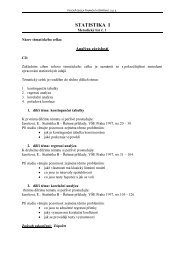
![The Business Creativity Module (BCM) [E_CEP]](https://img.yumpu.com/51112375/1/184x260/the-business-creativity-module-bcm-e-cep.jpg?quality=85)

